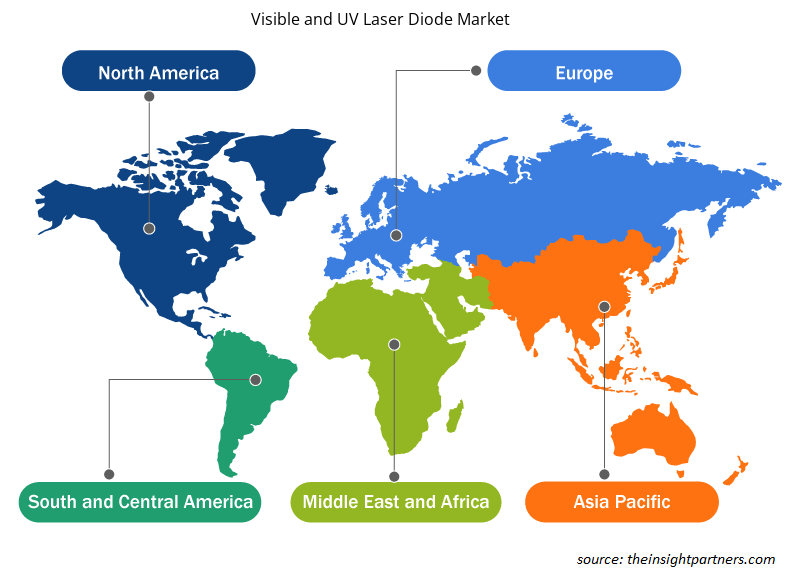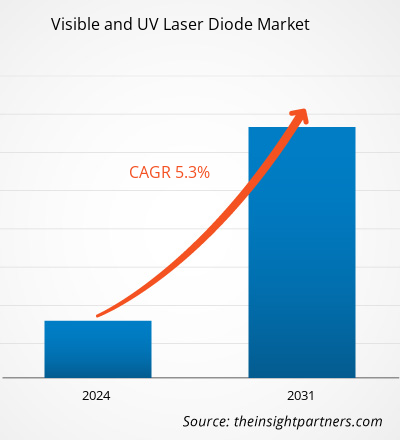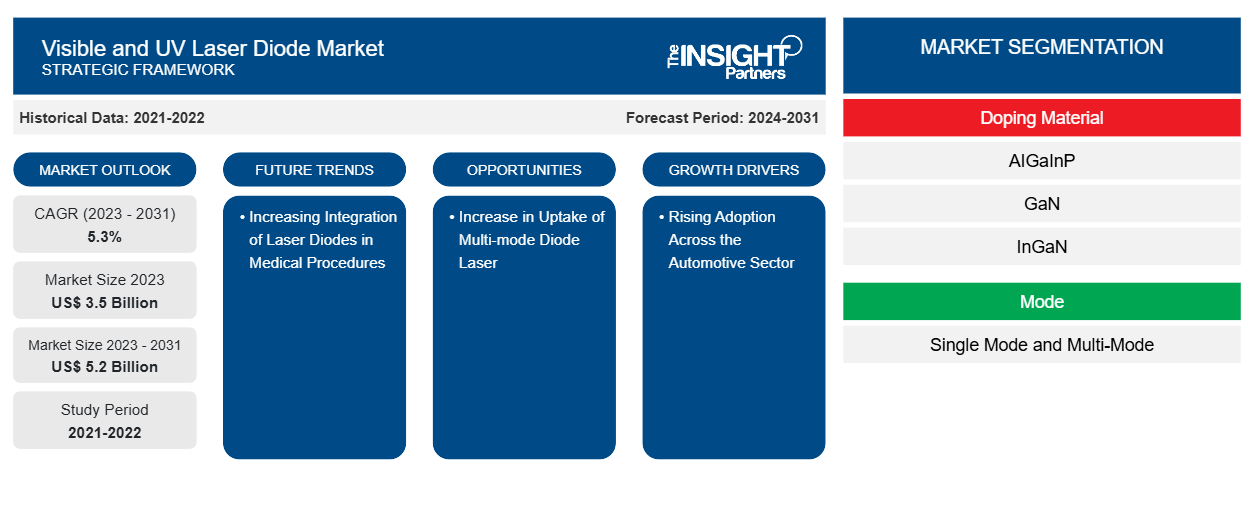Der Markt für sichtbare und UV-Laserdioden soll von 3,5 Milliarden US-Dollar im Jahr 2023 auf 5,2 Milliarden US-Dollar im Jahr 2031 anwachsen. Der Markt wird zwischen 2023 und 2031 voraussichtlich eine durchschnittliche jährliche Wachstumsrate von 5,3 % verzeichnen. Die zunehmende Integration von Laserdioden in medizinische Verfahren dürfte ein wichtiger Trend auf dem Markt bleiben.
Marktanalyse für sichtbare und UV-Laserdioden
Der Markt für sichtbare und UV-Laserdioden umfasst eine Reihe von Laserdioden, die Licht im sichtbaren und ultravioletten Spektrum aussenden können und in verschiedenen Branchen wie Telekommunikation, Fertigung, Gesundheitswesen, Medien und Unterhaltung Anwendung finden. Dieser Trend wird vor allem durch die zunehmende Verbreitung von Hochleistungslaserdioden in autonomen Fahrzeugtechnologien und die wachsende VCSEL-Technologie für Anwendungen wie die Gesichtserkennung durch Smartphones vorangetrieben. Diese Trends deuten darauf hin, dass die Aussichten für die Märkte für sichtbare und UV-Laserdioden äußerst positiv sind und in den kommenden Jahren Wachstumschancen bieten.
Marktübersicht für sichtbare und UV-Laserdioden
Sichtbare und UV-Laserdioden sind Halbleiterbauelemente, die Licht im sichtbaren und ultravioletten Teil des Spektrums emittieren. Diese Halbleiter finden breite Anwendung in sichtbaren Laserdioden : optische Speicherung, Laserdruck, medizinische Geräte und industrielle Prozesse. Normalerweise emittieren sichtbare Laserdioden Licht mit roten, grünen oder blauen Wellenlängen und werden je nach Gerät wie Laserpointer, Barcode-Lesegeräte und optische Laufwerke verwendet. UV-Laserdioden hingegen arbeiten mit Licht im ultravioletten Bereich für Anwendungen wie Fluoreszenzanregung, biomedizinische Instrumente, Halbleiterprüfung und andere. Sichtbare und UV-Laserdioden bilden eine kleine Einheit für Anzeigegeräte, die energieeffiziente und kohärente Lichtemitter sind; daher sind sie Kernbestandteile mehrerer Verbraucher-, Industrie- und wissenschaftlicher Geräte.
Passen Sie diesen Bericht Ihren Anforderungen an
Sie erhalten kostenlos individuelle Anpassungen an jedem Bericht, einschließlich Teilen dieses Berichts oder einer Analyse auf Länderebene, eines Excel-Datenpakets sowie tolle Angebote und Rabatte für Start-ups und Universitäten.
-
Holen Sie sich die wichtigsten Markttrends aus diesem Bericht.Dieses KOSTENLOSE Beispiel umfasst eine Datenanalyse von Markttrends bis hin zu Schätzungen und Prognosen.
Markttreiber und Chancen für sichtbare und UV-Laserdioden
Steigende Akzeptanz im gesamten Automobilsektor
Der Markt für sichtbare und UV-Laserdioden erfreut sich in der Automobilindustrie großer Beliebtheit, da die Nachfrage nach Hochtechnologien wie LiDAR-Systemen und selbstfahrenden Autos steigt. Der Bedarf an Hochleistungslaserdioden für die neuesten Anwendungen war ein Hauptgrund für die Einführung dieser Laserdioden. Dies wird den Markt voraussichtlich im Einklang mit dem Wachstumstrend in der Automobilindustrie antreiben. Dies bedeutet, dass die erhöhte Nachfrage nach Hochtechnologien, insbesondere LiDAR- Systemen und autonomem Fahren, zu einer zunehmenden Abhängigkeit von sichtbaren und UV-Laserdioden beigetragen hat und somit ihre unverzichtbare Rolle bei der Gestaltung der Zukunft der Anwendungen in der Automobiltechnologie beweist. Diese Tatsache wird noch dadurch unterstrichen, dass die kontinuierliche Forschung im Bereich der Laserdiodentechnologien und deren Integration in spezifische Anwendungen für den Automobilsektor die Grundlage für die Unverzichtbarkeit solcher Komponenten für die technologische Entwicklung der Branche festigt.
Steigende Verbreitung von Multimode-Diodenlasern
Der aktuelle Markt für sichtbare und UV-Laserdioden zeigt, dass Multimode-Diodenlaser zunehmend eingesetzt werden, was relative Vorteile bei höherer Leistung und Effizienz zu bieten scheint. Diese erhöhte Einsatzrate deutet auf eine steigende Präferenz für vielseitigere und leistungsstärkere Laserdioden für verschiedene Anwendungen hin, was den Markt weiter ausbaut. Mit ihrer hohen Leistung und erhöhten Effizienz finden Multimode-Diodenlaser in großem Maßstab Anwendung in den Bereichen Industrie und Wissenschaft. Ihre Fähigkeit, im Vergleich zu einigen anderen Lasertypen höhere Leistungsstufen mit verbesserter Effizienz zu liefern, hat sie zu einer wichtigen Komponente verschiedener Systeme/Anwendungen gemacht, was ihr Wachstum aufgrund der zunehmenden Einsatzfähigkeit vorantreibt und so zum Gesamtwachstum des Marktes für sichtbare und UV-Laserdioden beiträgt.
Segmentierungsanalyse des Marktberichts für sichtbare und UV-Laserdioden
Wichtige Segmente, die zur Ableitung der Marktanalyse für sichtbare und UV-Laserdioden beigetragen haben, sind Dotierungsmaterial, Modus und Anwendung.
- Basierend auf dem Dotiermaterial ist der Markt in AIGaInP, GaN und InGaN segmentiert. Das AIGaInP-Segment hatte im Jahr 2023 einen bedeutenden Marktanteil.
- In Bezug auf den Modus ist der Markt in Singlemode und Multimode segmentiert. Das Singlemode-Segment hielt im Jahr 2023 einen bedeutenden Marktanteil.
- Basierend auf der Anwendung ist der Markt in Industrie, Verteidigung, wissenschaftliche Medizin und andere segmentiert. Das Industriesegment hatte im Jahr 2023 einen bedeutenden Marktanteil.
Marktanteilsanalyse für sichtbare und UV-Laserdioden nach Geografie
Der geografische Umfang des Marktberichts für sichtbare und UV-Laserdioden ist hauptsächlich in fünf Regionen unterteilt: Nordamerika, Asien-Pazifik, Europa, Naher Osten und Afrika sowie Süd- und Mittelamerika.
Die Dynamik, Trends und Einflüsse, die berücksichtigt werden, variieren je nach den verschiedenen untersuchten geografischen Gebieten auf dem Markt für sichtbare und UV-Laserdioden. Der Schwerpunkt liegt auf zukünftigen Trends und Chancen auf dem europäischen Markt und einer gründlichen Analyse des wahrscheinlichen Investitionswerts in der Region. Dies wird durch einen Ausblick auf die Wettbewerbslandschaft unterstützt, der wichtige Hersteller und ihre Strategien angesichts einer proaktiven Haltung zur Bewältigung des Marktwettbewerbs in der Region berücksichtigt. In Nordamerika wird der Markt von vielseitigen Elementen angetrieben, wie der wachsenden Nachfrage nach modernster Lasertechnologie aus militärischen Anwendungen und der sichtbar vorgeschlagenen Verwendung von UV-Laserdioden zur Behandlung verschiedener Hautkrankheiten, was eine vielschichtige Marktlandschaft mit Anwendungen in verschiedenen Sektoren sowohl in der Verteidigung als auch im Gesundheitswesen widerspiegelt.
Regionale Einblicke in den Markt für sichtbare und UV-Laserdioden
Die regionalen Trends und Faktoren, die den Markt für sichtbare und UV-Laserdioden während des gesamten Prognosezeitraums beeinflussen, wurden von den Analysten von Insight Partners ausführlich erläutert. In diesem Abschnitt werden auch die Marktsegmente und die Geografie für sichtbare und UV-Laserdioden in Nordamerika, Europa, im asiatisch-pazifischen Raum, im Nahen Osten und Afrika sowie in Süd- und Mittelamerika erörtert.

- Erhalten Sie regionale Daten zum Markt für sichtbare und UV-Laserdioden
Umfang des Marktberichts für sichtbare und UV-Laserdioden
| Berichtsattribut | Details |
|---|---|
| Marktgröße im Jahr 2023 | 3,5 Milliarden US-Dollar |
| Marktgröße bis 2031 | 5,2 Milliarden US-Dollar |
| Globale CAGR (2023 - 2031) | 5,3 % |
| Historische Daten | 2021-2022 |
| Prognosezeitraum | 2024–2031 |
| Abgedeckte Segmente |
Durch Dotieren von Materialien
|
| Abgedeckte Regionen und Länder |
Nordamerika
|
| Marktführer und wichtige Unternehmensprofile |
|
Marktteilnehmerdichte für sichtbare und UV-Laserdioden: Auswirkungen auf die Geschäftsdynamik verstehen
Der Markt für sichtbare und UV-Laserdioden wächst rasant, angetrieben durch die steigende Endverbrauchernachfrage aufgrund von Faktoren wie sich entwickelnden Verbraucherpräferenzen, technologischen Fortschritten und einem größeren Bewusstsein für die Vorteile des Produkts. Mit steigender Nachfrage erweitern Unternehmen ihr Angebot, entwickeln Innovationen, um die Bedürfnisse der Verbraucher zu erfüllen, und nutzen neue Trends, was das Marktwachstum weiter ankurbelt.
Die Marktteilnehmerdichte bezieht sich auf die Verteilung der Firmen oder Unternehmen, die in einem bestimmten Markt oder einer bestimmten Branche tätig sind. Sie gibt an, wie viele Wettbewerber (Marktteilnehmer) in einem bestimmten Marktraum im Verhältnis zu seiner Größe oder seinem gesamten Marktwert präsent sind.
Die wichtigsten Unternehmen auf dem Markt für sichtbare und UV-Laserdioden sind:
- ASML Holding NV
- Coherent, Inc.
- IPG Photonics
- Newport Corporation
- Nuvoton Technology Corporation
- ProPhotonix
Haftungsausschluss : Die oben aufgeführten Unternehmen sind nicht in einer bestimmten Reihenfolge aufgeführt.

- Überblick über die wichtigsten Akteure auf dem Markt für sichtbare und UV-Laserdioden
Marktnachrichten und aktuelle Entwicklungen für sichtbare und UV-Laserdioden
Der Markt für sichtbare und UV-Laserdioden wird durch die Erfassung qualitativer und quantitativer Daten nach Primär- und Sekundärforschung bewertet, die wichtige Unternehmensveröffentlichungen, Verbandsdaten und Datenbanken umfasst. Nachfolgend sind einige der Entwicklungen auf dem Markt für sichtbare und UV-Laserdioden aufgeführt:
- ROHM hat mit der RLD90QZW8 eine Hochleistungslaserdiode entwickelt. Sie eignet sich ideal für Industrieanlagen und Verbraucheranwendungen, bei denen Distanzmessung und räumliche Erkennung erforderlich sind.
(Quelle: ROHM CO., LTD., Unternehmenswebsite, November 2023)
- IPG Photonics Corporation (Nasdaq: IPGP), der weltweit führende Anbieter von Faserlasertechnologie, gab heute die Markteinführung von drei Tief-Ultraviolett-Lasern (Deep UV) mit seinen proprietären nichtlinearen Kristallen bekannt, die im Vergleich zu Lasern mit herkömmlichen Frequenzumwandlungsmaterialien robustere und flexiblere Lösungen bieten.
(Quelle: IPG Photonics Corporation, Unternehmenswebsite, Januar 2023)
Marktbericht zu sichtbaren und UV-Laserdioden – Abdeckung und Ergebnisse
Der Bericht „Marktgröße und Prognose für sichtbare und UV-Laserdioden (2021–2031)“ bietet eine detaillierte Analyse des Marktes, die die folgenden Bereiche abdeckt:
- Marktgröße und Prognose für sichtbare und UV-Laserdioden auf globaler, regionaler und Länderebene für alle wichtigen Marktsegmente, die im Rahmen des Geltungsbereichs abgedeckt sind
- Markttrends für sichtbare und UV-Laserdioden sowie Marktdynamik wie Treiber, Einschränkungen und wichtige Chancen
- Detaillierte PEST/Porters Five Forces- und SWOT-Analyse
- Marktanalyse für sichtbare und UV-Laserdioden, die wichtige Markttrends, globale und regionale Rahmenbedingungen, wichtige Akteure, Vorschriften und aktuelle Marktentwicklungen umfasst
- Branchenlandschaft und Wettbewerbsanalyse, die die Marktkonzentration, Heatmap-Analyse, prominente Akteure und aktuelle Entwicklungen für den Markt für sichtbare und UV-Laserdioden umfasst
- Detaillierte Firmenprofile
- Historische Analyse (2 Jahre), Basisjahr, Prognose (7 Jahre) mit CAGR
- PEST- und SWOT-Analyse
- Marktgröße Wert/Volumen – Global, Regional, Land
- Branchen- und Wettbewerbslandschaft
- Excel-Datensatz
Aktuelle Berichte
Verwandte Berichte
Erfahrungsberichte
Grund zum Kauf
- Fundierte Entscheidungsfindung
- Marktdynamik verstehen
- Wettbewerbsanalyse
- Kundeneinblicke
- Marktprognosen
- Risikominimierung
- Strategische Planung
- Investitionsbegründung
- Identifizierung neuer Märkte
- Verbesserung von Marketingstrategien
- Steigerung der Betriebseffizienz
- Anpassung an regulatorische Trends























 Kostenlose Probe anfordern für - Markt für sichtbare und UV-Laserdioden
Kostenlose Probe anfordern für - Markt für sichtbare und UV-Laserdioden